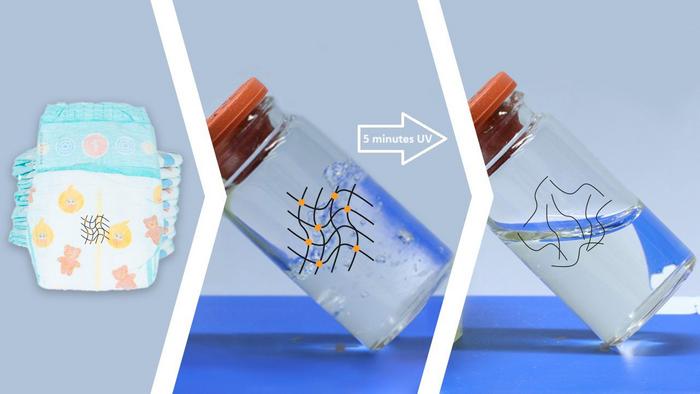Superabsorbers can be found in diapers as well as in a number of other hygiene and medical products, such as bandages and dressing materials. So far, strong acids have been required to recycle sodium polyacrylate, the highly absorbent material. These crosslinked polymers are insoluble in water. At high temperature, they do not melt, but only degrade. The acids, however, “cut” the chains stabilizing the polymers after about 16 hours at 80 degrees Celsius and, hence, enabled recycling. This process is complex and expensive, which is why superabsorbers have hardly been reused. Annually, about two million tons of them end up in the trash or are incinerated.

Credit: Collage: Ken Pekarsky, KIT
Superabsorbers can be found in diapers as well as in a number of other hygiene and medical products, such as bandages and dressing materials. So far, strong acids have been required to recycle sodium polyacrylate, the highly absorbent material. These crosslinked polymers are insoluble in water. At high temperature, they do not melt, but only degrade. The acids, however, “cut” the chains stabilizing the polymers after about 16 hours at 80 degrees Celsius and, hence, enabled recycling. This process is complex and expensive, which is why superabsorbers have hardly been reused. Annually, about two million tons of them end up in the trash or are incinerated.
Liquid in Five Minutes Instead of 16 Hours
Researchers from the Institute of Biological and Chemical Systems, the Institute for Biological Interfaces, and the Institute for Chemical Technology and Polymer Chemistry of KIT have now found that the crosslinked sodium polyacrylate polymers degrade under UV light after the uptake of water. “The chains that link the polymers are broken by the light. Then, they are so loose that they swim in water and turn into liquid fibers,” Pavel Levkin, Professor at the Institute of Biological and Chemical Systems, explains. For their studies, the researchers cut out the liners from conventional diapers, wetted them with water, and exposed them to a lamp of 1000 W. After five minutes already did the solid material turn into a liquid that dropped into a collector. “This method with UV light is about 200 times faster than with acids,” Levkin says.
The Recycled Polymers Can Be Used in Various Ways
The team then used known processes to convert the liquid into new adhesives and dyes. “The observation that the substance is soluble and processible was of high importance. Most probably, it can be turned into many other products,” the scientist explains.
For their tests, the researchers used clean diapers. But it is also possible to separate the superabsorbers from used diapers. “Hence, there is no reason why close-to-reality use should not be possible,” Levkin says. The recycling method can be optimized ecologically at no cost by using solar power. “We have found a promising strategy for recycling superabsorbers. This will significantly reduce environmental pollution and contribute to a more sustainable use of polymers.”
Original Publication
Shuai Li, Johannes M. Scheiger, Zhenwu Wang, Birgit Huber, Maxi Hoffmann, Manfred Wilhelm, Pavel A. Levkin: Diapers to Thickeners and Pressure-Sensitive Adhesives: Recycling of Superabsorbers via UV Degradation. ACS Appl. Mater. Interfaces, 2023. https://doi.org/10.1021/acsami.3c06999
Being “The Research University in the Helmholtz Association”, KIT creates and imparts knowledge for the society and the environment. It is the objective to make significant contributions to the global challenges in the fields of energy, mobility, and information. For this, about 9,800 employees cooperate in a broad range of disciplines in natural sciences, engineering sciences, economics, and the humanities and social sciences. KIT prepares its 22,300 students for responsible tasks in society, industry, and science by offering research-based study programs. Innovation efforts at KIT build a bridge between important scientific findings and their application for the benefit of society, economic prosperity, and the preservation of our natural basis of life. KIT is one of the German universities of excellence.
Journal
ACS Applied Materials & Interfaces
DOI
10.1021/acsami.3c06999
Method of Research
Experimental study
Subject of Research
Not applicable
Article Title
Diapersto Thickenersand Pressure-SensitiveAdhesives:Recyclingof Superabsorbersvia UV Degradation
Article Publication Date
7-Sep-2023
COI Statement
The authors declare no competing financial interest.




